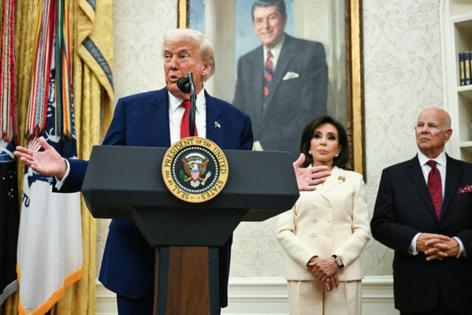Trump bristles at 'TACO' trade that bets on him backing down
Published in News & Features
WASHINGTON — President Donald Trump bristled at suggestions that Wall Street believes he’s ultimately unwilling to follow through on extreme tariff threats, saying his repeated retreats are instead part of a strategy to exert trade concessions.
“It’s called negotiation,” Trump said Wednesday, adding that he intentionally would “set a number at a ridiculous high number” and then “go down a little bit” as part of talks.
Trump was asked during an Oval Office event to respond to reports of a so-called “TACO” trade, in which investors seize on market tumbles after the president makes tariff threats, predicting he will ultimately relent and equities will rebound.
The acronym — which stands for Trump Always Chickens Out — was coined by a Financial Times columnist and has since been adopted by traders attempting to navigate the dozens of changes to tariff policy Trump has announced over the early months of his presidency.
In the most recent case, stocks tumbled Friday after Trump threatened to impose a 50% tariff on European goods beginning June 1, only to rally after he agreed to delay the levies more than a month to allow for negotiations.
Trump’s tariff policy has been marked by frequent retreats and recalibrations. Consider:
—As Trump’s 145% levies on Chinese imports drove fears of soaring costs for consumer goods and threatened a recession, the U.S. president agreed to roll back duties on most of those goods to 30%. The detente announced May 12 — which was matched by a pullback from Beijing — followed talks between the world’s two largest economies and is designed to allow at least 90 days for additional negotiations.
—Trump ignited market turmoil and a pullback from U.S. treasuries in April when he hit dozens of U.S. trading partners with levies as high as 50%. The White House denied a report of a possible reprieve, and the president took to social media, urging investors to “BE COOL!” while calling it A GREAT TIME TO BUY!!” Hours later, Trump announced he was pausing his higher tariffs, resetting them to 10% for 90 days in a bid for talks. In response, stocks staged their best rally since 2008.
—Trump’s March announcement he was slapping a 25% tariff on imported automobiles and auto parts ignited furious lobbying by carmakers who said the levies would cripple the industry and undermine investments made under Trump’s renegotiated North American trade deal. A month later, Trump yielded to that pressure, effectively easing separate metals duties for the auto industry while offering a temporary offset for American-made vehicles.
—Consumers had fretted about higher expected prices for consumer electronics under Trump’s April tariffs, when the administration in a surprise move exempted smartphones, computers and other technology. Administration officials said those tariff exclusions were designed to allow time for the Commerce Department to conduct a separate trade probe targeting semiconductors.
All of those moves followed Trump’s earlier retreats on sweeping Canada and Mexico tariffs, as well as shifting plans to collect levies on low-cost packages.
Still, the stock market has increasingly been shrugging off Trump’s tariff threats, shrinking the money-making potential of the TACO trade. A recent analysis from Dennis DeBusschere of 22V Research found that the S&P 500 Index’s sensitivity to tariffs has fallen dramatically since April.
A little more than a third of the S&P 500’s daily move now can be explained by tariff-related headlines — in line with a long-term median for any factor that can tip the market, the data show. That’s down from 80% in early April.
The benchmark index is up since every key tariff-related announcement that initially set the markets on edge. The S&P 500 has gained 1% since the March 4 tariffs on Canada, Mexico and China, and it is higher by 4% since the April 2 announcement of levies on trading partners.
“The thesis behind the TACO trade is: Buy the Trump tariff dip,” Tom Essaye of the Sevens Report wrote in a note to clients on Wednesday. “Essentially, Trump has proven to investors that he won’t actually follow through with draconian tariffs. As such, any sell-off following a dramatic tariff threat should be bought.”
The president argues his approach — threaten big levies and use the leverage to exact concessions — has yielded quick success.
For instance, after Trump vowed a 50% tariff on goods from Colombia unless the country accepted deportees, Colombian President Gustavo Petro ultimately backed down, accepting those deportation flights.
Yet analysts have warned the tactic offers diminishing returns every time Trump scales back a previous threat, since counterparties are less likely to view them as credible from the start.
On Wednesday in the Oval Office, a reporter’s question about the TACO trade elicited a fiery response from Trump, who said he was more often criticized for being too harsh in his executive actions. He labeled the query “nasty.”
“They wouldn’t be over here today negotiating if I didn’t put a 50% tariff on,” Trump said. “The sad thing is, now, when I make a deal with them — it’s something much more reasonable — they’ll say, ‘Oh, he was chicken. He was chicken.’ That’s unbelievable.”
©2025 Bloomberg L.P. Visit bloomberg.com. Distributed by Tribune Content Agency, LLC.







Comments